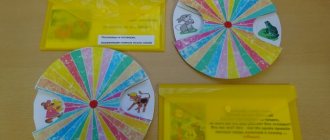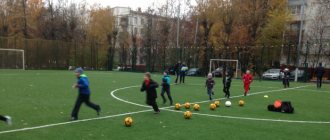Preschool age is the period of introduction to the world of universal human values, this is the time of establishing the first relationships with people. An important role in the development of a child’s personality is played by the process of learning to know oneself, express one’s emotions, and understand the emotional state of one’s interlocutor. Children's knowledge of themselves, understanding of the emotional state and actions of other people forms empathy in the child. A young child (up to three years old) is practically unable to show empathy towards other people. But gradually, in preschool age, we can observe the first manifestations of empathy.
The ability to empathize develops when conditions are met and at the same time are stages of the development of empathy:
- gaining your own positive experience;
- awareness of one's own emotions and feelings;
- awareness of what the other person supposedly feels.
Empathy is one of the conditions for effective communication with people around you. The ability to put oneself in the place of another helps to better understand a communication partner, identify individual character traits and their manifestation, expressed in actions and actions. Children learn to be tolerant of other people's shortcomings, learn empathy, and conflict-free communication.
Today there is no doubt that almost all Russian children require some kind of psychological support. This is accompanied by a number of unfavorable factors: economic and political instability; large flow of information; uncontrolled process of using modern gadgets. Which leads to a lack of full-fledged communication. In the age of technological progress, people communicate less and less with each other, preferring watching television programs and virtual communication. Often, parents work ten hours a day, in pursuit of money to pay off loans, and plan their vacation, giving preference to TV and smartphones rather than communication and spending time together with their children. Parents more often care about the physical and intellectual development of the child, and emotional and personal development seems to them not so important, which leads to disruption of communication with peers and adults.
Scientific research by S.I. Semenaka, I.Yu. Kulagina, V.S. Mukhina, V.N. Myasishcheva, D.B. Elkonin in the field of education and development of children showed that many emotional and personal difficulties that children face are largely due to the characteristics of family upbringing.
Emotions are the first manifestation of the psyche in ontogenesis, the basis of psychological health, the foundation of motivation and creative activity. Connecting with the development of the will, emotional characteristics highlight the individuality and uniqueness of the individual. With the help of emotions and feelings, the child signals to adults about his well-being, desires, and needs.
Observing children in kindergarten, you can notice how role-playing games have faded and the number of anxious, emotionally unbalanced children has increased. In this connection, it is important to begin work on the development of the emotional and personal sphere precisely in preschool age, so that in the future children grow up as psychologically healthy individuals who can fully communicate and correctly express their emotions.
At the present stage, preschool education is the first stage of lifelong education, which is reflected in the Federal State Educational Standard (FSES).
One of the main principles of the Federal State Educational Standard is the personal developmental and humanistic nature of interaction between adults: parents (legal representatives), teachers and other employees of the educational organization and children. The federal state educational standards state that the preschool education program should be aimed at creating conditions for the child’s development that open up opportunities for his positive socialization, his personal development, the development of initiative and creativity based on cooperation with adults and peers and age-appropriate activities; to create a developing educational environment, which is a system of conditions for the socialization and individualization of children (clause 2.4.).
Based on the principles and conditions of education according to the Federal State Educational Standard, one of the main tasks of a preschool educational organization is the emotional and personal development of children, and includes the formation of adequate behavior, skills to manage negative emotions, a conscious attitude to the norms of social behavior, and the ability to constructively build relationships with others.
Having studied the features of the development of the emotional and personal sphere of preschoolers in ontogenesis, the following positive point can be noted: in a kindergarten, children have a unique opportunity to complete their image, the structure of their “I”. A child can strengthen or acquire the positive qualities of this image, based on the assessments of others, interactions with peers and other adults, successes and failures in activities and communication.
Self-awareness manifests itself in desires, the desire for self-knowledge, and activity. The emotional-affective sphere, recorded in memory and reflected in speech, is the basis for the awareness and development of the “I-concept” of the child’s personality. Self-awareness, self-expression, self-esteem, self-realization are based on conscious and meaningful emotional-expressive activity organized by an adult.
The preschool period is one of the periods of formation of the hierarchy of motives and primary ethical standards. The activity of an individual is regulated by subordinate motives and ethical norms and rules. It is during preschool age that voluntary behavior arises and develops in children. Arbitrariness - the presence of not only a goal, but also means and ways of achieving it - is an important psychological support for the development of a child’s personality.
The emotional sphere is an important component in the development of children. The emotions of preschool children are situational and unstable. The child is not yet capable of long-term sympathy and care for others, even very beloved people.
Throughout preschool childhood, the child’s emotions acquire depth and stability. In older preschoolers, one can already observe genuine concern for loved ones, altruistic actions aimed at protecting them from anxiety and grief. One of the main directions of development of emotions in preschool age is an increase in their “reasonableness”, associated with the mental development of the child. The child begins to explore the world around him, become familiar with the consequences of his actions, and understand what is good and what is bad. “Reasonableness” also extends to feelings associated with the child’s own behavior. Already at the age of one year, praise is available to the child, and this pleases him, and the reproach of an adult upsets him.
External manifestations of emotions also change significantly in preschool childhood. The child gradually masters the ability to restrain violent, harsh expressions of feelings to a certain extent. Unlike a two-year-old child, a five- to six-year-old preschooler can hold back tears, hide fear, etc. As they grow older, preschoolers are able to assimilate the “language of emotions” accepted in society. They can use various forms of their expression using glances, facial expressions, gestures, postures, movements, voice intonations, and notice the subtlest shades of experiences. In preschool age, pronounced constitutional and facial changes occur in the child’s face, which is associated with the growth of the facial skull, transformation of the jaws and changes in the structure of the cheeks. During this period, the child more fully masters facial expressions and bodily expression. Communication with adults and peers teaches the child to master facial expressions through his identification with the emotions of those with whom he communicates. By the age of five, some consciously controlled expressions are formed, for example, a demonstratively “honest” facial expression with an open gaze directed into the eyes of an adult, when in reality the child is hiding something. However, in general, the facial reactions of a child under six years of age are very spontaneous and his face is readable like an open book.
The need for recognition in preschool age is expressed in the child’s desire to establish his moral qualities. The child tries to anticipate the reaction of other people to his action, while he wants people to be grateful to him and recognize his good deeds. Having arisen in the process of communication with adults, the need for recognition is subsequently transferred to relationships with peers. Since play is the leading activity in preschool age, aspirations are primarily worked out in the game itself and in real relationships regarding the game. In the game, the need for recognition manifests itself in two ways: on the one hand, the child wants to “be like everyone else,” and on the other, “to be the best.” Children are guided by the achievements and behaviors of their peers.
Mastering the social space, the conditions of human development and existence, which are determined by the values and meanings of his rights and responsibilities, accumulating certain knowledge about them, the child does not realize their significance for a long time. The behavior of a preschooler changes depending on situations in which one or another motive governs. The subordination of motives is the most important new formation in the development of the personality of a child of senior preschool age. The hierarchy of motives gives a certain direction to the child’s entire behavior; it becomes possible to evaluate not only certain actions, but also behavior in general.
From all of the above, it is clear how important it is to develop the emotional and personal sphere in the preschool period. On the one hand, this directly affects the development of empathy, which leads to the formation of adequate self-esteem in the child and the development of emotional voluntariness, on the other hand, the child acquires constructive ways to manage his own behavior, which largely determines the degree of readiness of the child for learning and favorable adaptation to school .
| An article in support of the project “Stories on the Sand” (a program for the development and correction of the emotional and personal sphere in children from 2 to 8 years old using sand play therapy methods)”, the “Golden Psyche” competition based on the results of 2022 |
Emotional impact
The secret of raising a preschooler with the help of emotional influence is not to suppress the child’s emotions, but to direct them in the right direction.
If a child attends kindergarten, then his emotional development will be more effective, since he will be in the company of peers and, together with them, comprehend new things, learn to communicate with them.
Work on the emotional improvement of preschoolers should be carried out in two directions:
- developing the ability to recognize and compare emotions: fun, boring, sad, calm, scary, interesting, etc.
- developing the ability to correctly express emotions and identify the emotions experienced by others.
The emotional impact on the child is carried out by the following means:
- role-playing games
- psycho-gymnastic games
- outdoor games
- communication games
- games and tasks to develop arbitrariness
- games for developing imagination
- game exercises
- mimic sketches
- listening to music and discussing it
- reading fairy tales and stories
- acquaintance with painting.
During classes, the child will experience different emotional states, will try to talk about what he feels, will get acquainted with the experiences of the same children, thanks to which he will begin to better understand himself and those around him.
Formation of the emotional sphere
The formation of emotions and feelings in preschoolers depends on the following conditions:
- A preschooler must communicate with peers: it is in communication that feelings and emotions are formed.
- It is necessary to organize purposeful activities that promote the development of emotions and feelings (listening to music, music lessons, reading).
- It is best to develop emotions and feelings in preschoolers through their main activity - play.
- Labor and creative activity helps to form emotional experiences: joy from success, inspiration, sympathy for the efforts of peers, a feeling of satisfaction or dissatisfaction with the result.
Components of successful formation of the emotional sphere of a preschooler:
- Proper organization of the child’s routine, comfortable for him.
- Activation of the baby’s motor activity, his physical development (morning exercises, outdoor games, physical education sessions).
- Games (role-playing, story-based, didactic, communicative, etc.).
- Introduction to art and independent creativity.
- Reading and discussing fairy tales.
- Psycho-gymnastics (emotional sketches, facial expressions, pantomime).
- Organization of joint activities of children.
- Tasks using visual aids.
Emotions are the basis for a child’s successful mental state, his successful communication, development and future life. The baby reacts to the world around him through emotions. Therefore, it is necessary to develop the emotional sphere of a child from an early age using different types of influence, giving preference to play methods.
Diagnostics
Basic diagnostic methods for the emotional sphere of children:
- testing
- observation
- survey
- conversation
- survey
- analysis of samples of children's creativity (drawings).
When observing a preschooler, pay attention to factors such as emotional background, mood, degree of expression of emotions, level of emotional mobility. By observing, you can easily notice how rich the child’s emotional background is, whether the child knows how to control his emotions, whether he is characterized by emotional instability
Using one of the diagnostic methods or in combination, you can find out:
- How adequate is the preschooler’s reaction to phenomena?
- how he perceives and interprets the states and moods of other people
- the breadth of the range of emotions that the child understands and experiences, the depth of his experiences, ways of conveying emotions through speech;
- Is it appropriate to display emotions during communication?
These methods can be used by both professional child psychologists and kindergarten teachers.








